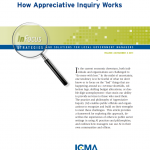Topic: Leadership Development

Positive Problem-Solving: How Appreciative Inquiry Works
In the current economic downturn, both individuals and organizations are challenged to “do more with less.” In the midst of uncertainty, one tendency is to be fearful of what we don’t know or to focus on the “bad” things that are
happening around us—revenue shortfalls, collection lags, shifting budget allocations, or double-digit unemployment that strain our ability to provide services to those who need them. The practice and philosophy of Appreciative Inquiry (AI) enables public officials and organizations to recognize and build on their strengths to meet these challenges. This article provides a framework for exploring this approach, describes the experiences of others in public sector settings in using AI practices and philosophies, and outlines how managers can use AI in their own communities and offices.
Cite as:
Lee, S., Henderson, M., Whitaker, G ““Positive Problem-Solving: How Appreciative Inquiry Works” ICMA Press, vol. 43, Number 3, 2011
…
Continued
Consensus Building and Leadership
There appears to be a consensus on consensus building in public administration: We are for it. Consensus building is an important skill for managers and leaders in terms of responsiveness, participation, managing in an age of diffuse power centers, and building more durable outcomes. This chapter pushes beneath this comfortable degree of agreement to critique what is known about consensus building, identifies issues on leadership from inside and outside of consensus-building processes, and proposes essential questions for leadership research to bridge the gap between practice and theory on consensus building.
Cite as:
Morse, Ricardo S., et al. Transforming Public Leadership for the 21st Century, Routledge, 2007. ProQuest Ebook Central, http://ebookcentral.proquest.com/lib/unc/detail.action?docID=1899942.
Created from unc on 2019-04-02 09:46:23.
…
Continued
Innovations in Public Leadership Development
This book is grounded in several premises widely shared by our contributors. First, leaders can, and indeed must, be developed if the public sector is to meet its obligations to citizens and its constituents. It is just not the case or our experience that leaders are born and in short supply. Second, although it has some common attributes, public leadership differs from leadership in other contexts, such as military, sports, or business. Military models of leadership, for example, remain focused on hierarchical structures of authority, whereas public leaders now find themselves leading much more in a collaborative environment. Third, the practice of public leadership is in crisis, or at least in turmoil, necessitating new ways of leading and alternative ways of developing leaders. Public confidence in government is low, traditional ways of doing business are becoming obsolete, scandal appears to be permeating government, management and administration are becoming increasingly political, and the quality of public services seems on the decline. New leaders are desperately needed. And fourth, a wide variety of training and development innovations are underway that can, and are producing public leaders who have been or will be effective in today’s environment. These innovations, many presented here, are grounded in practice rather than theory, have been tested and evaluated for effectiveness, and are beginning to attract a large following in the field. The contributors hope that their work conveys the exciting times in which we find ourselves in the field of public management and the unprecedented opportunities for advancing leadership development.
Cite as:
Morse, Ricardo S., and Terry F. Buss. Innovations in Public Leadership Development, Routledge, 2008. ProQuest Ebook Central, http://ebookcentral.proquest.com/lib/unc/detail.action?docID=1900028.
Created from unc on 2019-04-02 09:16:13.
…
Continued
Collaborative Leadership Development for Local Government Officials
The increased emphasis on collaborative governance across the field of public administration necessitates a rethinking of what the core competencies of public managers are and how they might be developed. The traditional model of leadership development, focusing on leading within bounded hierarchy and via command-and-control must be moderated with an additional focus on collaborative problem solving, working in flattened structures, and incentivizing behavior in new ways. This article reviews relevant literature along with the experience of two local government leadership programs to explore content and training approaches needed to prepare local government leaders for collaborative governance. Qualitative and quantitative survey findings indicate that program content should specifically address collaboration competency development. Further, training evaluation strategy should allow for processing and reflection: immediate reaction surveys should be supplemented with a long-term evaluation strategy. Finally, while scholarly literature recommends non-traditional, peer-learning activities for collaborative leadership development, this research offers mixed support. The program examples and associated research findings highlight the importance of a strategic approach to training that reflects emerging leadership needs.
Cite as:
GETHA-TAYLOR, H., & MORSE, R. (2013). COLLABORATIVE LEADERSHIP DEVELOPMENT FOR LOCAL GOVERNMENT OFFICIALS: EXPLORING COMPETENCIES AND PROGRAM IMPACT. Public Administration Quarterly,37(1), 71-102. Retrieved from http://www.jstor.org/stable/24371989
…
Continued
